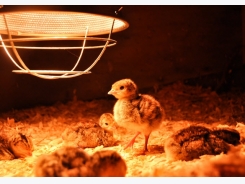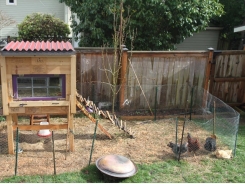How to Raise Chickens for Farm-Fresh Eggs

Both bantams, this male Serama (left) and female Cochin sport a genetic trait called frizzle, which produces crimped feathers.
From choosing breeds and caring for chicks to tricking out a coop here's what you need to get crackin'.
It started innocently enough. In the spring of 2010, shortly after Duluth, Minnesota, passed an ordinance allowing residents to keep chickens, my husband, Jason, came home from the feed store bearing a couple of baby buff Orpingtons and three Rhode Island Reds.
We set the chicks up in a kiddie pool in the garage, eventually moving them to a coop Jason cobbled together from sheets of corrugated metal. The birds came when called and seemed to enjoy being petted by our two young children. And the eggs! Who knew that a backyard diet of grass and bugs, supplemented with quality chicken feed, could result in eggs with such bright flavors, robust yolks that stand up tall when fried, and whites that whisk into gorgeous meringues?
Watching our happy hens scratch the earth, Jason felt a sense of accomplishment he’d never experienced in his day job as a grant writer. So when he was laid off that summer, and learned that no area stores carried pasture-raised eggs, my husband got to scheming. We spent the next few months attending conferences and classes for beginning farmers, consulting state agencies about regulations, and finding the perfect 10-acre parcel for rent 35 miles outside of town. In June, we took delivery of 900 pullets (young chickens on the verge of laying eggs) and housed them in a series of DIY hoop coops. Locally Laid, our pasture-raised egg company, was born.

Chicken enthusiasts favor the American breed Wyandotte for its hardiness and dependable laying more than 200 eggs a year.

Available only in bantam (small) size, Sebrights make up for lousy laying with striking good looks.
Jason and I may have gone a tad farther than most, but we’re certainly not the only folks aboard the chicken bandwagon. Chicken-sitting services have popped up in places like Seattle, Los Angeles, and Portland, Oregon. It’s hard to find a major metropolitan area these days that doesn’t host at least one chicken-coop tour. In fact, the American Poultry Association reports that its membership has doubled since 2006. Pet-like and productive, these birds offer more than mere companionship or even a steady supply of eggs. The determined foragers also cut down on pests while providing garden-enhancing manure. Is it any wonder this “gateway livestock” draws more and more curious hobbyists into a farm-centric way of life?
Getting Started
Before dashing out to buy a few, or several hundred, chicks, you’ll first need to determine how many your local zoning regulations permit and how many your property can accommodate, given a ratio of roughly one bird per 10square feet of pasture. Assuming eggs are the end goal (“broilers,” or meat birds, are a whole different enterprise, and not the focus of this story), you’ll want to weigh matters of quality and quantity: Are you after large eggs, or a large number of eggs, or particularly beautiful green and blue eggs? Other attributes to consider when choosing breeds include cold- and heat-tolerance, temperament, and plain old good looks. If size matters, you should know that most breeds come in small bantam forms that weigh about 75 percent less than standard birds. Be forewarned, though, that while no chicken qualifies as a skilled flier, bantams are better at it than full-size fowl. (See “Fine-Feathered Friends,” below.)
You can jump-start the process, as Jason and I did for our commercial venture, by ordering ready-to-lay pullets, but you’ll miss out on the experience of bonding with baby chicks. You can also snatch up whatever young birds happen to be at your local farm-supply store, as we did during our initial descent into chicken madness you’ll know you’re getting chickens suited to your region. For a wide variety of breeds, however, order from a reputable online hatchery such as Iowa’s Murray McMurray, Ohio’s Meyer, or Texas’s Ideal Poultry. (Bonus: Any company that ships across state lines must maintain fully vaccinated breeding stock, monitored for disease by the National Poultry Improvement Plan, a program created in the 1930s.)

You’ll know a Cochin by its feathered legs.

Remember Foghorn Leghorn of Looney Tunes fame? His loud personality is typical of the Leghorn breed.

Developed in England during the early 20th century, Modern Game bantams, like this Red Pyle, are distinguished by their upright posture.
While exotic breeds such as the Cream Legbar can run $30 or more per chick, most cost around $3 each when purchased in straight runs (groups of mixed gender) and less than $5 each in groups sorted by sex. Obviously, it’s the ladies who lay eggs, and they don’t need a rooster to do so. In fact, many municipalities ban male birds and their endless crowing. But cocks do contribute something crying out if predators threaten the hens.
Housing and Feeding Your Birds
Your hatchlings will demand a special home, called a brooder, for six weeks (see “Bringing Up Babies,” below) before transitioning to a coop. There’s a wide variety of prefab coops on the market, at prices that start under $100 and go way up, though you can also build your own or retrofit an existing shed. The henhouse essentials include windows for ventilation, nesting boxes for egg-laying, and horizontal beams for roosting. (Roosting, or perching an instinct passed down from the birds’ wild ancestors, who slept in trees for safety allows chickens to air their tail feathers and snuggle up for warmth.) You’ll also want a screened outdoor run, whether attached to the henhouse or not, to indulge another instinctive behavior: dust-bathing, basically digging and rolling in dirt, which absorbs excess moisture from feathers and skin and repels fleas and lice. (See the key features of a chicken coop.)

If it’s pastel-colored eggs you’re after, the Ameraucana is your gal.

Polish chickens, like the white-crested example here, tend to behave erratically, an attribute you can chalk up to their feather-impaired vision.

Belgian d’Uccle (this one’s coloring is known as mille fleur) won’t give you many eggs, but can you beat that footwear?
When the chickens move to their new home, at six weeks, it’s also time to change their diet, from starter feed (see “Bringing Up Babies,” below) to grower feed. The latter comes in crumbles (which chickens seem to prefer) and pellets (less messy and easier on humans). Kuhl makes a hanging feeder with a feed-saver grill that helps cut down on spillage ($65; flemingoutdoors.com). Because chickens don’t have teeth, they require insoluble stone grit to grind up food in their gizzards. Most commercial feeds include it, but you can also set out a bowl of the stuff, especially for birds on organic feed or those who spend their days foraging. Once the hens begin laying eggs, at around 21 weeks, switch to layer feed (in crumble or pellet form), which delivers extra calcium, phosphorous, and other nutrients; supply frequent foragers with a side of calcium-rich crushed oyster shells as well. Feel free to leave the food in the run, as chickens tend to self- regulate and rarely gorge. One exception: They’ll happily gobble up your leftovers; just limit such treats to less than 10 percent of their diet.
A much healthier way to supplement store-bought feed is through foraging. Let the birds out early in the morning, and they’ll hunt for bugs, seeds, and frogs until dusk. Be sure to rotate the flock around your pasture, shifting to a new grassy area after the omnivores denude the spot they’re on. You can use portable fences to create makeshift paddocks or, in places with busy roads or where predators are a threat, enlist a chicken tractor essentially a chicken run on wheels.
Laying hens, which produce an egg almost every day, drink nearly twice as much water as roosters and non-laying hens on average, half a liter a day. Make cool water available in the run during all waking hours. A waterer with a lip, hung from the run’s ceiling, ensures things stay clean (3-gallon waterer, $30; mypetchicken.com). When temperatures dip below 32°F, move the waterer and feeder inside the henhouse, and set the waterer atop a poultry water heater ($43; mypetchicken.com), elevated off the floor with a cinderblock. To keep your birds warm, stack insulating hay bales around the outside of the henhouse (not inside, where they’ll trap moisture and encourage mold). While heat lamps may be tempting, they can lead to coop fires. Artificial heat-ing also prevents the birds’ bodies from gradually adjusting to colder temperatures, meaning a loss of power could kill them.

Did you know that unfertilized eggs can be kept unrefrigerated for weeks? (Just don’t was off their protective coating.)
Handling Health Issues
Because chickens have fast metabolisms and high body temperatures, any sickness they contract will progress quickly. If you notice listlessness, coughing, sneezing, standoffishness, or other unusual behavior, isolate the hen in question and stir a powdered vitamin-electrolyte product into her water, refreshing it twice a day. You can seek advice from your county agricultural agent, local extension office, or, if the chicken’s health seems to decline rapidly, a qualified farm vet. Also, keep an eye out for similar signs among the rest of the brood.
Don’t be alarmed, however, if your chickens start to look bedraggled near the end of summer. The shortening days signal that it’s time to molt, and the birds begin shedding old feathers and growing new ones for insulation. Laying will wane and may stop altogether, as the birds direct their energy and nutrients toward the new growth. Lastly, a note about broody hens: Occasionally, one will want to sit on a clutch of eggs until they hatch. Removing her from the eggs and moving her nesting box can help snap her out of the broodiness, though it may take weeks.
Reaping the Benefits
The hard work of chicken-keeping pays off in the form of freshly laid eggs. Pasture-raised birds can lay eggs with a third less cholesterol, a quarter less saturated fat, and two-thirds more vitamin A than typical commercially produced eggs. Plus, homegrown ones can be stored, unrefrigerated, for several weeks, as long as they’re unwashed and unfertilized. (If there’s a rooster about, refrigerate the eggs within 36 hours.) Before consuming an egg, wash it under hot water to remove the protective cuticle; the water must be significantly warmer than the egg because of the porous nature of shells. In the six years since my husband returned from the feed store with those five fateful chicks, our operation has grown to include partner farms and some 20,000 birds. While my role these days is mostly limited to washing eggs, I know the answer to that age-old question: The chicken always comes first.

Above all, chicks require warmth before their downy fluff gives way to insulating feathers.
Bringing Up Babies
Whether your chicks come from the local feed store or an online hatchery, the newbies will need special treatment for six weeks namely, a warm place free from predators and a diet geared to their tiny bodies.
Build a brooder You can buy a brooder kit outfitted with a heat lamp and feeder for around $85 online, or simply repurpose a cardboard box or kiddie pool to house your chicks. The container should provide at least half a square foot of floor space per chick. Spread a 2- to 3-inch layer of pine shavings across the bottom of the brooder and cover the top with ½-inch metal mesh to keep growing birds from flapping out.
Heat things up Hang a 250-watt infrared heat lamp on an adjustable chain about 18 inches above one side of the brooder and set a thermometer inside. You’ll want the temperature at 95°F the first week. Raise the bulb a bit each week to decrease the temperature by five degrees, reaching 70°F by week six.
Feed your flock Commercially formulated starter feed comes in mash or crumble form (pellets are tough for little birds to eat), often medicated to combat the potentially fatal disease coccidiosis. If your babies have already been vaccinated for coccidiosis, choose unmedicated feed to avoid rendering the vaccine null. Serve the food, and especially water, in specialized chick containers, as tiny birds can drown in a bowl of water.
FINE-FEATHERED FRIENDS
Though all chickens originate from the jungles of Southeast Asia, the birds have been bred over millennia to favor various climates and fulfill a number of human preferences, involving everything from a layer’s looks and disposition to the number and color of the eggs she produces. These 11 all-stars, most of which are available in standard and bantam sizes, represent some of the most popular breeds in this country. Female chicks should cost less than $5 apiece, except where noted.
Leghorn

Better suited to hot regions (that large comb is susceptible to frostbite), this Italian bird lays a decent number of white eggs (around 180 per year), but proves a poor urban pet due to its skittish and noisy demeanor.
Ameraucana

This U.S. variation on Chile’s Araucana breed boasts gorgeous green and blue eggs, the ability to withstand high and low temperatures, and a docile disposition. The downside? Relatively low production (160 medium eggs annually).
Plymouth Rock

Cold-hardy, heat-tolerant, and productive (200 large brown eggs a year), this American bird is also fine of feather: Haberdashers and fly-fishing tie makers favor its plumage. In white, bluff, black, or barred (striped), it’s also raised for meat.
Orpington

Native to the U.K., the pet-like Orpington is available in buff, black, white, and blue colors. The breed is comfortable in a wide range of climates; it lays about 180 large brown eggs annually.
Silkie

This looker distinguishes itself with hairlike feathers and five toes instead of the usual four. The cold-tolerant Chinese breed can take longer than most to begin laying its cream-colored eggs, delivering only about 100 a year. (Females can run about $12 each.)
Sumatra

Closely related to the original jungle fowl of Asia, this bird thrives in hot, humid conditions and is more inclined to fly than most. Though a poor layer (100 medium white eggs a year), the Sumatra sports a spectacular tail that can extend up to four feet in males.
Rhode Island Red

This all-American workhorse typically does well in both heat and cold. Beloved for its maternal, easygoing nature and prolific laying (about 250 extra-large brown eggs a year), it can also be raised for meat.
Barnevelder

Bred in the Netherlands, this mild-mannered, winter-hardy bird wears a cloak of black, white, or brown feathers and lays about 200 large dark-brown eggs a year. The pricey ($10 or more per female) chicken is farmed for its meat, too.
Araucana

The Chilean bird lays some 150 exquisite light-blue and green eggs a year. Friendly and both heat-and cold-tolerant, the Araucana is difficult to breed a genetic quirk causes a high percentage of chicks to die in the shell. (Females fetch upwards of $30 each.)

Australorp

Australia’s take on the Orpington, this super-friendly bird lays an average of 250 large brown eggs a year and does well in both warm and cold climates. It also produces quality meat.
About Author: Lucie B. Amundsen is the author of the new book Locally Laid: How We Built a Plucky, Industry-Changing Egg Farm From Scratch (Penguin Random House)
(Photographs by Aliza Eliazarov)
Có thể bạn quan tâm
Phần mềm

Phối trộn thức ăn chăn nuôi

Pha dung dịch thủy canh

Định mức cho tôm ăn

Phối trộn phân bón NPK

Xác định tỷ lệ tôm sống

Chuyển đổi đơn vị phân bón

Xác định công suất sục khí

Chuyển đổi đơn vị tôm

Tính diện tích nhà kính

Tính thể tích ao hồ




 N&H TOPLINE: Researchers develop method for making new…
N&H TOPLINE: Researchers develop method for making new…  How to Convert a Chicken Coop into a…
How to Convert a Chicken Coop into a…